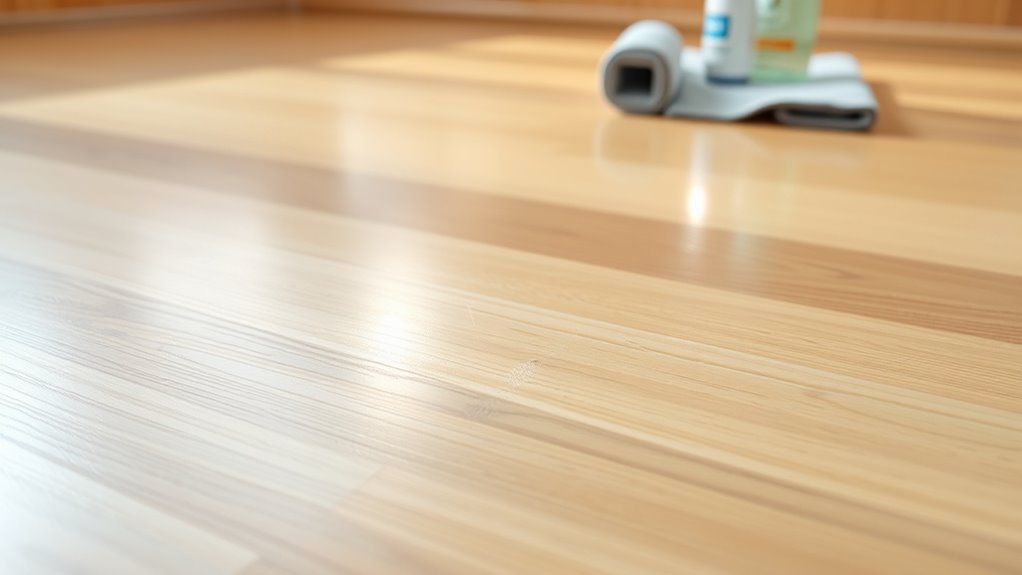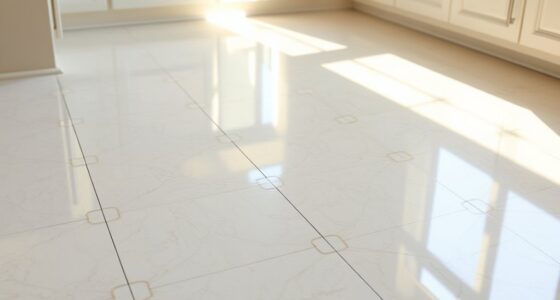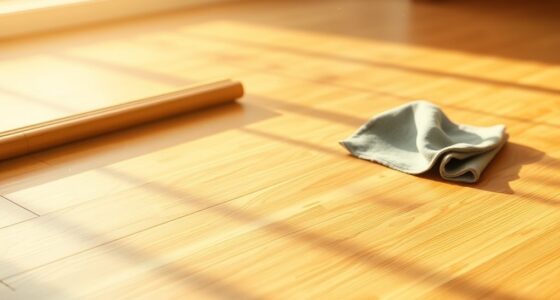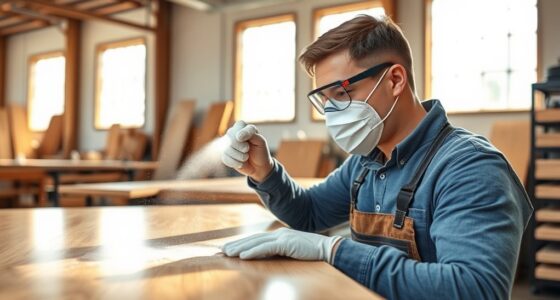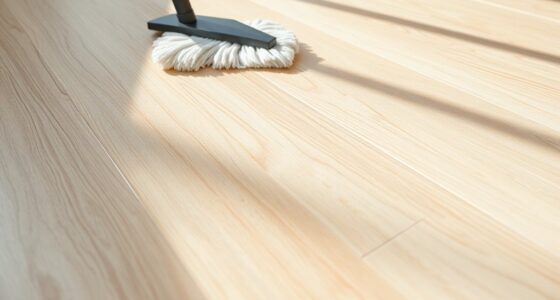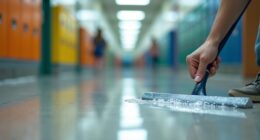Before mopping your sealed hardwood floors, start by removing dirt and debris with a soft broom or vacuum using a gentle attachment. Confirm the protective coating is intact and free of scratches or dullness, as this helps prevent damage during cleaning. Avoid excessive water and harsh chemicals, sticking to cleaners made for hardwood. Taking these steps now will protect your floors’ surface and keep them looking new longer—continue to learn how to maintain their beauty effectively.
Key Takeaways
- Clear the floor of dirt and debris with a soft broom or vacuum attachment before mopping.
- Inspect and reapply protective polyurethane coating if scratches or dullness are present.
- Use a damp mop with a cleaner formulated for sealed hardwood floors, avoiding excess water.
- Place felt pads on furniture legs to prevent scratches during cleaning or movement.
- Avoid harsh chemicals like ammonia or bleach that can damage the protective finish.
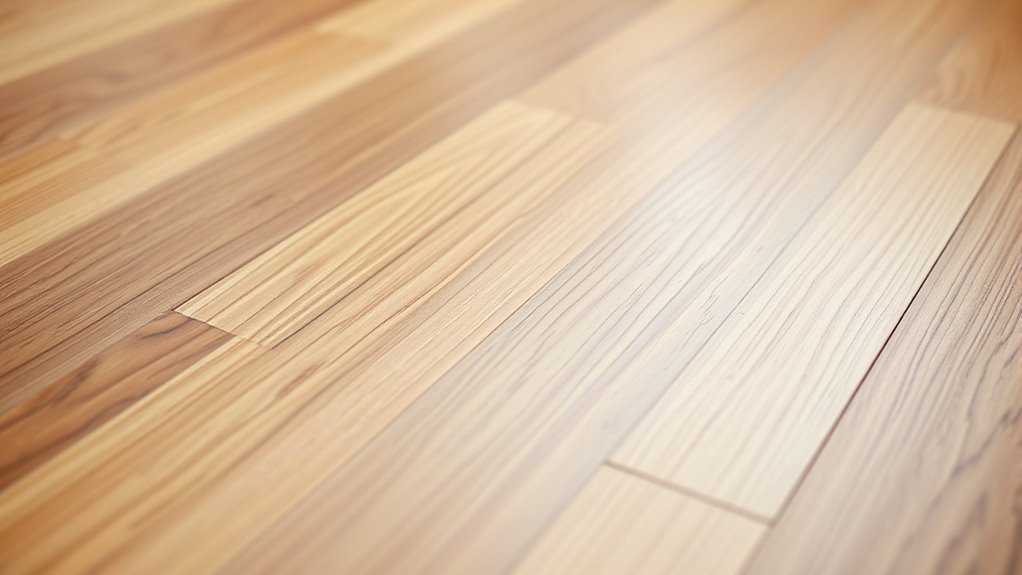
Scratches on sealed hardwood floors can be frustrating, but you don’t have to accept them as inevitable. The good news is that you can minimize damage and keep your floors looking their best by adopting the right cleaning techniques and applying protective coatings. Before you reach for your mop, it’s essential to understand how proper cleaning and preventative measures work together to preserve your floor’s finish and prevent scratches.
First, focus on gentle cleaning techniques. Regular sweeping or vacuuming removes dirt, grit, and debris that can scratch the surface when walked on or mopped. Use a soft-bristled broom or a vacuum with a hardwood floor attachment to avoid abrasive particles. When it’s time to mop, opt for a damp mop rather than a soaking wet one. Excess water can seep into seams and weaken the sealant, making your floor more vulnerable to scratches and water damage. Use a cleaner specifically designed for sealed hardwood floors—avoid harsh chemicals like ammonia or bleach, which can strip the protective coating and lead to dullness or scratches over time. Proper cleaning methods are crucial for maintaining the longevity and appearance of your hardwood floors.
Regular sweeping and damp mopping protect sealed hardwood floors from scratches and damage.
Another critical step is applying protective coatings. These coatings act as a barrier, safeguarding the hardwood from scratches, stains, and moisture. Polyurethane is a popular choice because it creates a durable, clear finish that resists daily wear and tear. If your floors already have a protective coating, consider reapplying it periodically to restore their resilience. Before mopping, ensure the protective layer is intact; if you notice scratches or dullness, a fresh coat can help reinforce the surface. Remember, a well-maintained protective coating makes cleaning easier and reduces the risk of scratches caused by dirt or debris trapped in cleaning cloths.
In addition to cleaning and coatings, think about adding felt pads to furniture legs and area rugs in high-traffic zones. These small steps considerably reduce direct contact and friction that can scratch the finish. Always lift furniture when moving it instead of dragging it across the floor. This simple action prevents unnecessary scratches and preserves the integrity of your sealant.
Frequently Asked Questions
Can I Use Vinegar to Clean Sealed Hardwood Floors?
Yes, you can use vinegar for hardwood cleaning, but vinegar safety is important. Mix a small amount of vinegar with water to create a gentle cleaner, ensuring it’s well-diluted to avoid damage. Use a damp mop—not soaked—and avoid harsh scrubbing. Vinegar can effectively clean sealed hardwood floors, but too much or undiluted vinegar may harm the finish. Always test a small area first to prevent any issues.
How Often Should I Inspect for Scratches on My Hardwood?
Think of your hardwood floors as a treasured painting; regular inspection keeps it pristine. You should check for scratches and damage once a month, especially in high-traffic areas. This frequent inspection helps you catch issues early, ensuring proper floor protection. By maintaining a consistent schedule, you prevent small scratches from becoming big problems, keeping your floors looking beautiful and prolonging their lifespan.
Are There Specific Mops Best Suited for Sealed Hardwood?
You should use a microfiber mop for sealed hardwood, as its soft materials prevent scratches and trap dust effectively. Avoid harsh materials like rough sponges or stiff-bristled brooms. When cleaning, use gentle, circular motions and a damp mop—not soaked—to protect your floor’s finish. Regularly rinse and launder the microfiber pad to maintain cleaning efficiency. This careful approach guarantees your hardwood stays scratch-free and beautifully maintained over time.
Can Pet Claws Cause Permanent Scratches on Sealed Floors?
Pet claws can create lasting scars on your sealed floors if you’re not careful. Think of their claws as tiny chisels that can carve into the surface, making scratches hard to erase. To prevent this, keep claws trimmed and use scratch prevention mats in high-traffic areas. Regular maintenance and gentle cleaning safeguard your floors, ensuring your hardwood stays shimmering and scratch-free, even with your playful pets around.
What Are Natural Remedies to Prevent Scratches?
To prevent scratches naturally, apply a layer of wood floor wax regularly to add a protective barrier. Use furniture pads on the bottoms of your furniture and pet beds to minimize contact with the floor. Keep pet claws trimmed to reduce scratching risk. These simple steps help preserve your sealed hardwood’s finish, keeping it looking new longer without harsh chemicals. Regular maintenance and precautions make a big difference.
Conclusion
Now that you’ve taken these simple steps, your hardwood gleams with a smooth, polished shine, free from tiny scratches that mar its beauty. Imagine each gentle pass of your mop gliding effortlessly, revealing the rich, warm tones beneath. With a little care, your floors stay pristine, inviting you to walk barefoot and feel the soft, flawless surface beneath your feet. Keep up this routine, and your hardwood will continue to tell stories of elegance and care for years to come.
